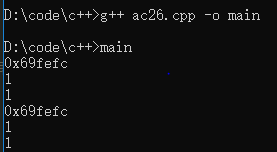函数指针是指向函数的指针变量。 因此“函数指针”本身首先应是指针变量,只不过该指针变量指向函数。这正如用指针变量可指向整型变量、字符型、数组一样,这里是指向函数。如前所述,C在编译时,每一个函数都有一个入口地址,该入口地址就是函数指针所指向的地址。有了指向函数的指针变量后,可用该指针变量调用函数,就如同用指针变量可引用其他类型变量一样,在这些概念上是大体一致的。函数指针有两个用途:调用函数和做函数的参数。
1 #include<stdio.h> 2 int max(int x,int y){return (x>y? x:y);} 3 int main() 4 { 5 int (*ptr)(int, int); 6 int a, b, c; 7 ptr = max; 8 scanf("%d%d", &a, &b); 9 c = (*ptr)(a,b); 10 printf("a=%d, b=%d, max=%d", a, b, c); 11 return 0; 12 }
以上来自百度百科
函数指针指向的是函数而非对象。和其他指针一样,函数指针指向某种特定类型。函数的类型由它的返回类型和形参类型共同决定,与函数名无关:
bool length_compare(const string &, const string &);
该函数的类型是 bool(const string &, const string &);想要声明一个指向该函数的指针,只要用指针替换函数名即可:
1 #include <iostream> 2 using namespace std; 3 4 bool leng_compare(const string &s1, const string &s2){ 5 return s1.size() > s2.size(); 6 } 7 8 int main(void){ 9 //pf指向一个函数,该函数的参数是两个 const string 的引用,返回值是 bool 类型 10 bool (*pf) (const string &, const string &);//未初始化 11 return 0; 12 }
注意 *pf 两端的括号必不可少的。如果不写这对括号,则 pf 是一个返回值为 bool 指针的函数。
使用指针函数:
当我们把函数名作为一个值使用时,该函数自动地转换成指针:
#include <iostream> using namespace std; bool leng_compare(const string &s1, const string &s2){ return s1.size() > s2.size(); } int main(void){ //pf指向一个函数,该函数的参数是两个 const string 的引用,返回值是 bool 类型 bool (*pf) (const string &, const string &);//未初始化 pf = leng_compare;//pf指向名为 leng_compare 的函数 cout << &pf << endl; cout << *pf << endl; cout << pf << endl; pf = &leng_compare;//和上面的那条赋值语句是等价的,即取地址符是可选的 cout << &pf << endl; cout << *pf << endl; cout << pf << endl; return 0; }

此外,我们还能直接使用指向函数的指针调用该函数,无需提前解引用指针:
#include <iostream> using namespace std; bool leng_compare(const string &s1, const string &s2){ return s1.size() > s2.size(); } int main(void){ //pf指向一个函数,该函数的参数是两个 const string 的引用,返回值是 bool 类型 bool (*pf) (const string &, const string &);//未初始化 pf = leng_compare;//pf指向名为 leng_compare 的函数 bool flag1 = pf("acfjls", "fjsl");//调用leng_compare函数 bool flag2 = (*pf)("fjlsfld", "jfs");//一个等价调用 bool flag3 = leng_compare("fjslfjs", "jfkdl");//另一个等价调用 return 0; }
指向不同函数类型的指针间不存在转换规则。但是和往常一样,我们可以为函数指针赋一个 nullptr 或者值为 0 的常量表达式,表示该指针没有指向任何一个函数。
重载函数的指针:
当我们使用重载函数的指针时,上下文必须清晰地界定到底应该选用哪个函数。编译器通过指针类型确定选用哪个函数,指针类型必须与重载汉萨中的某一个精确匹配:
1 #include <iostream> 2 using namespace std; 3 4 int gel(int* x){} 5 6 int gel(unsigned int x){} 7 8 int main(void){ 9 int cnt = gel(1);//单独函数调用是可以不是精确匹配,只要能有最佳匹配即可 10 // int (*pf1)(int) = gel;//错误:形参列表不能精确匹配 11 // double (*pf2)(int*) = gel;//错误:和第一个gel函数返回类型不匹配,和第二个gel函数形参不匹配 12 int (*pf3)(unsigned int) = gel;//正确 13 return 0; 14 }
函数指针形参:
和数组类似,虽然不能定义函数类型的形参,但是形参可以是指向函数的指针。此时形参看起来是函数类型,实际上却是当成指针使用:
1 #include <iostream> 2 using namespace std; 3 4 bool length_compare(const string &, const string &){} 5 6 //第三个形参是函数类型,它会自动转换成指向函数的指针 7 void max(const string &s1, const string &s2, bool pf(const string &, const string &)){} 8 //等价声定义,显示地将形参定义成指向函数的指针 9 // void max(const string &s1, const string &s2, bool (*pf)(const string &, const string &)){}; 10 11 int main(void){ 12 max("fjs", "jfls", length_compare);//把函数当作为实参使用,此时它会自动地转换成指针 13 return 0; 14 }
可以使用 typedef 定义自己的类,简化函数使用函数指针:
1 #include <iostream> 2 using namespace std; 3 4 bool length_compare(const string &, const string &){} 5 6 // gel1 和 gel2 是等价的函数类型 7 typedef bool gel1(const string &, const string &); 8 typedef decltype(length_compare) gel2; 9 10 //gel3 和 gel4 是等价的指针类型 11 typedef bool(*gel3)(const string &, const string &); 12 typedef decltype(length_compare) *gel4; 13 14 //需要注意的是这里的 decltype 返回的是函数类型,此时不会将函数类型自动转换成指针类型,只有在 decltype 返回结果前加上 * 才能得到指针 15 16 void max(const string &s1, const string &s2, gel1){}//编译器自动将gel1转换成指针类型了 17 18 // void max(const string &s1, const string &s2, gel3){}//等价声明 19 20 int main(void){ 21 max("fjs", "jfls", length_compare);//把函数当作为实参使用,此时它会自动地转换成指针 22 return 0; 23 }
返回指向函数的指针:
和数组类似,虽然不能返回一个函数,但是能返回指向函数类型的指针。然而,我们必须把返回类型写成指针的形式,编译器不会自动地将函数返回类型当成对应的指针类型处理。而想要声明一个返回函数指针的函数,可以直接声明,使用类型别名,尾置类型等:
1 #include <iostream> 2 using namespace std; 3 4 using gel1 = int(int*, int);//gel1是函数类型,不是指向函数的指针 5 using gel2 = int(*)(int*, int);//gel2是指向函数的指针 6 // typedef int (*gel3)(int*, int);//gel2的等价类型 7 8 // gel1 lou(int x);//错误:gel1是函数类型,不是指针类型 9 gel2 lou(int x); 10 gel1* lou(int x); 11 int (*lou(int x))(int *, int);//不使用类型别名,直接声明 12 auto lou(int) -> int (*)(int *, int);//使用尾置返回类型 13 14 int main(void){ 15 return 0; 16 }
使用 decltype:
当我们明确知道返回的函数是哪一个,就能使用 decltype 简化书写函数指针返回类型的过程,需要注意的是 decltype 返回的不是指针,需要添加 *,这点和数组是一样的:
1 #include <iostream> 2 using namespace std; 3 4 int gel(int *, int); 5 6 decltype(gel) *lou(int x);//注意这里的*不能落掉 7 8 int main(void){ 9 return 0; 10 }